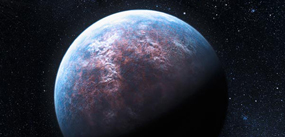Syllabus
AST s309L: Extraterrestrial Life
SYLLABUS
Second Summer Session 2013
MTWThF
1:00 - 2:30 pm
Classroom: RLM 5.104
Instructor: Michael Endl
e-mail: mike [at] astro.as.utexas.edu
phone: 512-471-8312
office: RLM 17.328
Office hours: Thu, 11:00am - 12:30pm
Teaching Assistant: Harrison Stinnett
e-mail: hstinnett [at] astro.as.utexas.edu
COURSE DESCRIPTION:
Did you ever wonder about one (or several) of the following questions?
- are we alone in the Universe?
- do other stars have planets too?
- is there current or past life on Mars?
- how many Earth-like planets do we know?
- what are the basic requirements for life as we know it?
- what kind of stars have planets?
- can we communicate with alien civilizations?
- how do we search for planets orbiting other stars?
- is there a liquid subsurface ocean on Jupiter's moon Europa?
- when did life first emerge on Earth?
- is our Solar System special?
- how can we probe atmospheres of planets in other star systems?
- can we detect life on other planets?
If the answer is "YES" then this summer course is for YOU! The course will discuss the current answers from modern astronomy, astrophysics and astrobiology. It is split roughly into two parts: part one will discuss exoplanets, e.g. planets orbiting stars other than the Sun, and part two will focus on the question whether there is life somewhere else in the Universe and how we can find it. The course level is designed for non-science majors. Basic mathematical and astronomical (AST 301) knowledge are required.

GOAL OF THE COURSE:
At the end of the course you will have a basic understanding of the astronomical techniques to detect and characterize exoplanets. You will also have an overview of the properties and statistics of exoplanets and their host stars. And you will have knowledge about astrobiological topics like what life is, how life works, what habitats of alien life we can imagine, and about the Search For Extraterrestrial Intelligence (SETI).
Textbooks:
The lecture slides represent the basis of this course (there will also be handouts). The slides for each class will become available (pdf files to download from UT Blackboard)
We have an optional textbook: "Life in The Universe" 3rd edition by Bennett and Shostak
Exams:
There will be a written exam at the end of each week (5 in total) about the 4 previous classes. Students can drop (or miss) one of the 5 exams. There will be 4 homework asignments. Final grade will be the average based on the 4 written exams, the 5 homeworks and attendance (75% exams, 20% homework and 5% attendance).
Grading Scheme:
90-100: A, 80-89: B, 70-79: C, 60-69: D, <60: F
COURSE SCHEDULE:
Week 1:
Scientific Method, Habitability of Earth, Life on Earth
Week 2:
Life in the Solar System: Mars, Europa, Titan, Enceladus
Week 3:
Planets around other stars I
Week 4:
Extrasolar Planets II: Kepler
Week 5:
SETI
Course Conduct:
Please turn off cell phones before you enter the classroom. Also, please do not leave class early unless you have talked to me in advance,
as consideration for your fellow students. Academic dishonesty, including cheating, plagiarism, and fabrication, as defined in the U of
Texas Honor Code (http://registrar.utexas.edu/archived/catalogs/gi07-08//app/appc03.html
- Sec-11-802-Scholastic-Dishonesty), is serious offense for which a disciplinary proceeding may be initiated. This includes copying any
homework assignments or exams. If very similar work is submitted, all parties involved will receive a zero for their assignment.
Questions:
e-mail: mike [at] astro.as.utexas.edu
